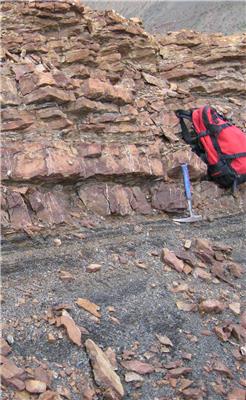

| Online: | |
| Visits: | |
| Stories: |

| Story Views | |
| Now: | |
| Last Hour: | |
| Last 24 Hours: | |
| Total: | |
The Great Dying: The Cold Exterminated All of Them
The Earth has known several mass extinctions over the course of its history. One of the most important happened at the Permian-Triassic boundary 250 million years ago. Over 95% of marine species disappeared and, up until now, scientists have linked this extinction to a significant rise in Earth temperatures.
Permian-Triassic boundary in shallow marine sediments, characterised by a significant sedimentation gap between the black shales of Permian and dolomites of Triassic age. This gap documents a globally-recognised regression phase, probably linked to a period of a cold climate and glaciation.
Teams of researchers led by Professor Urs Schaltegger from the Department of Earth and Environmental Sciences at the Faculty of Science of the UNIGE and by Hugo Bucher, from the University of Zürich, have been working on absolute dating for many years. They work on determining the age of minerals in volcanic ash, which establishes a precise and detailed chronology of the earth’s climate evolution. They became interested in the Permian-Triassic boundary, 250 million years ago, during which one of the greatest mass extinctions ever took place, responsible for the loss of 95% of marine species. How did this happen? for how long marine biodiversity stayed at very low levels ?
A technique founded on the radioactive decay of uranium.
Researchers worked on sediment layers in the Nanpanjiang basin in southern China. They have the particularity of being extremely well preserved, which allowed for an accurate study of the biodiversity and the climate history of the Permian and the Triassic. “We made several cross-sections of hundreds of metres of basin sediments and we determined the exact positions of ash beds contained in these marine sediments,” explained Björn Baresel, first author of the study.
By dating the various sediment layers, researchers realised that the mass extinction of the Permian-Triassic boundary is represented by a gap in sedimentation, which corresponds to a period when the sea-water level decreased. The only explanation to this phenomenon is that there was ice, which stored water, and that this ice age which lasted 80,000 years was sufficient to eliminate much of marine life. Scientists from the UNIGE explain the global temperature drop by a stratospheric injection of large amounts of sulphur dioxide reducing the intensity of solar radiation reaching the surface of the earth.
This study therefore shows that climate warming is not the only explanation of global ecological disasters in the past on Earth: it is important to continue analysing ancient marine sediments to gain a deeper understanding of the earth’s climate system.
Contacts and sources:
Citation: Timing of global regression and microbial bloom linked with the Permian-Triassic boundary mass extinction: implications for driving mechanisms Scientific Reports,
Björn Baresel1, Hugo Bucher2, Borhan Bagherpour2, Morgane Brosse2, Kuang Guodun3 &
Urs Schaltegger1
1Department of Earth Sciences, University of Geneva, Rue des Maraîchers 13, 1205 Geneva, Switzerland.
2Paleontological Institute and Museum, University of Zurich, Karl Schmid-Strasse 4, 8006 Zurich, Switzerland.
3Guangxi Bureau of Geology and Mineral Resources, Jiangzheng Road 1, 530023 Nanning, China. Correspondence
and requests for materials should be addressed to B.B. (email: [email protected])
Source: http://www.ineffableisland.com/2017/03/the-great-dying-cold-exterminated-all.html



